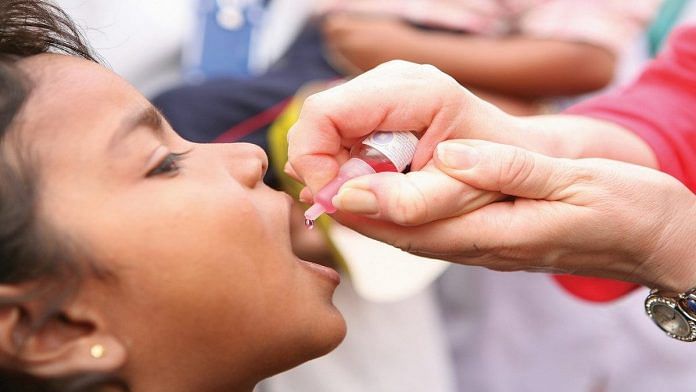
New Delhi: World Health Organization (WHO) executive director Michael J. Ryan this week pointed out that India has led the world in eradicating two pandemics, smallpox and polio, adding that the country has tremendous capacity in tackling the coronavirus crisis.
But India’s journey from being a hyperendemic region for polio to being completely polio-free spanned many decades with numerous hurdles on the way. Hyperendemic refers to persistent, high levels of disease occurrence.
India’s efforts to eradicate polio may indeed show that despite its population density, the country’s healthcare system has the capacity to reach every one of its citizens.
This, however, doesn’t really mean that it is now fully equipped to deal with the coronavirus. For one, the coronavirus is far more infectious and has a faster rate of transmission than the polio virus.
To add to that, the current fight against coronavirus is missing a key element — a viable vaccine against the virus.
Even with a vaccine, India’s war against polio lasted nearly 66 years until the country was declared polio-free in 2014.
Also read: Coronavirus: Latest updates on cases in India, all you need to know about COVID-19
The fight that began at time of Independence
The country’s fight against polio began in 1949 when the Indian Council of Medical Research (ICMR) established a Polio Research Unit in Bombay (now Mumbai). The second polio research unit in India was the Enterovirus Laboratory, established in 1964, at the Christian Medical College (CMC), Vellore, Tamil Nadu.
Both centres undertook studies that showed the country was hyperendemic to the poliovirus infection and paralytic poliomyelitis.
Poliovirus spreads by food or water containing infected human faeces, and sometimes from infected saliva. The infection causes muscles to weaken, often leading to fatal paralysis.
The first rounds of polio immunisation using imported oral polio vaccine (OPV) was introduced in Mumbai by the city corporation in 1964 and in Vellore by CMC in 1965. However, studies published soon after showed that the vaccine was not entirely effective.
Despite that, WHO’s Expanded Programme on Immunisation (EPI), which used the same oral poliovirus vaccine that was supposed to protect against three strains of the virus (P1,P2, P3), was implemented in the country in 1979 but the burden of the disease did not fall for about a decade.
In the 1980s, there were approximately 3,50,000 cases of polio every year worldwide, of which 1,50,000 were in India. A study published around this time showed that pulsing three doses of oral polio vaccine offered better immunisation.
That led to the concept of ‘pulse immunisation’ conducted in Vellore, which subsequently became the first Indian town to be polio-free in 1983.
A study commissioned in 1985, and published in 1999, showed that increasing the reach of the vaccine, as well as the frequency of doses led to a faster declined in incidence of polio.
Also read: This is how Karnataka govt will keep track of nearly 15,000 people under home quarantine
The decline in cases
By 1989, a decade after the launch of EPI in India the number of polio cases started to decline significantly — both due to direct vaccine efficacy and the indirect herd effect.
In 1994, a pilot immunisation campaign — popularly called Pulse Polio Immunisation (PPI) — was conducted in Delhi, targeting one million children up to three years of age after the successful Vellore experiment.
The programme was later expanded nationally in 1995, during which a total of 88 million under-3 children were immunised.
From the next year, the target age group was increased to all children under the age of five years. This resulted in further decline of the number of polio cases to 1,005 reported in 1996.
In 2003, the programme was further expanded to reach the marginalised sections of the society especially those living in ghettoised communities, lacking access to basic sanitary and healthcare services.
In the years since 2004, India started the annual pulse polio vaccination campaigns — conducted 10 times each year. Virtually every child was tracked and vaccinated.
The government would organise two National Immunisation Days (NIDs) each year usually in January and March. In the days leading up to the event, all sorts of promotion is done.
All children under five would be immunised on those days, with the help of volunteers who set up booths in almost every locality.
In 2014, India was finally declared polio-free.
Also read: Jodhpur jail inmates on hunger strike for 3 days now, want parole due to Covid-19

COMMENTS